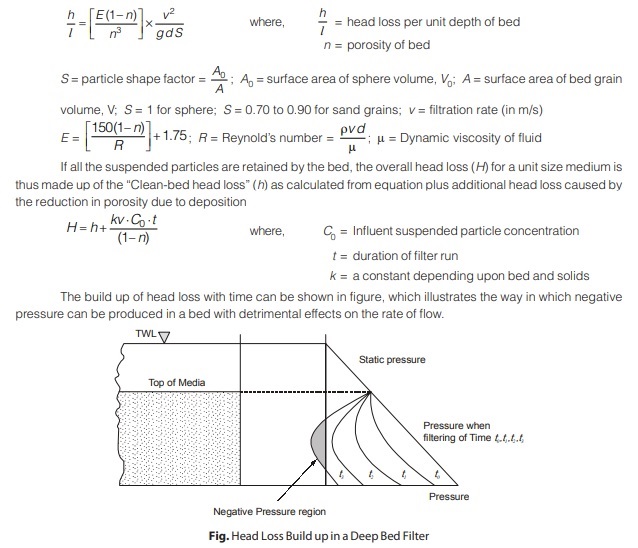Theory of Filtration
The filters, in fact purify the water under four different processes. These processes are summarized below:
Different Processes of Filtration
(a) Mechanical straining
(b) Sedimentation and Flocculation
(c) Biological action
(d) Electrolytic charges
(a) Mechanical Straining:
The suspended particles, which are bigger than the size of the voids in the sand of filter, get arrested in voids. The water passing the voids will be free from such particles. Most of the particles are removed in upper layer. Arrested particles including the coagulated floc forms a mat on top which further helps in straining.
(b) Sedimentation and Flocculation:
Infact, filters remove particles of size smaller than the size of voids present in the filter. These voids infact act like tiny coagulation-sedimentation units. The colloidal matter arrested in these voids is a gelatinous mass and hence, attracts other finer particles as well. These finer particles, thus, settle down in the voids and get removed.
(c) Biological Metabolism:
The sand bed has been identified as three zones of purification.
- When a new filter is put in commission and raw water is passed, during the first two weeks the upper layers of sand grains gets coated with a reddish brown sticky deposit of partly decomposed organic matter together with iron, manganese, aluminium and silica. This coating tend to absorb organic matter existing in the colloidal state. After two or three weeks, there exists a film of algae, bacteria and protozoa in the upper most layer of the sand to which are added the finely divided suspended material, plankton and other organic matter deposited by the raw water. This skin is called the “Schmutzdecke” and it acts on extremely fine meshed straining mat.
- The ‘autotrophic’ zone existing a few millimeters below the zone ‘Schmutzdecke’. A few millimeters below the schmutzdecke zone is known as autotrophic zone. In this zone, the growing plant life breaks down organic matter, decomposes the plankton and use available nitrogen, phosphates and carbon dioxide providing oxygen in their place. The filtrate becomes oxidized at this stage.
- The ‘heterotrophic’ zone, which ends around 300 mm into the bed. A few millimeters below the autotrophic zone, the heterotrophic zone extends around 300 mm into the bed. In this zone, the bacteria multiply to very large numbers and the breakdown of organic matter is completed and the resulting effluent consists of simple inorganic substances and unobjectionable salts. The bacteria act not only to breakdown organic matter but also to destroy each other and so tend to maintain a balance of life native to the filter so that the resulting filtrate is uniform. This process is predominant in slow sand filters.
(d) Electrolytic Charges:
The filter helps in purifying the water by changing the chemical characteristics of water. It may be explained by the fact that sand grains of filter media and the impurities in the water carry electrical charges of opposite nature. When these oppositely charged particles and impurities comes in contact with each other, they neutralise each other and thus changing the character of water and making it pure.
Flow Through Filter Media
Bed of sand are mostly used in the water treatment in the form of deep bed filters. The main purpose of the bed is to remove fine suspended solids. Other forms of porous uncompacted solids in deep beds are also used to provide adsorption and ion exchange process.
Porous Bed Hydraulics
The hydraulics of flow through porous beds, which applies to clean filters and to granular activated carbon and ion exchange beds is usually described by empirical relationship given by Karman Cozeny.
<< Previous | Next >>
Must Read: What is Environmental Engineering?

